Recent Developments in Small-Molecule Fluorescent Probes for Cellular Senescence
Abstract
:1. Introduction
2. Characteristics of Senescent Cells
2.1. Representative Features and Biomarkers in Senescent Cells
2.1.1. Changes in Cell Morphology
2.1.2. Telomere Shortening
2.1.3. Upregulation of Cell Cycle Inhibitory Proteins
2.1.4. Alterations in Cellular Organelles
2.1.5. Overexpression of Senescence-Associated Enzymes
2.1.6. Overabundance of Reactive Oxygen Species (ROS)
2.2. Inducers for Cellular Senescence
3. Detection of Senescent Cells
3.1. Previous Senescence Detection Methods
3.1.1. Colorimetric Analysis
3.1.2. Immunoassay Techniques
3.1.3. Telomere Shortening Detection (FISH Technique)
3.2. Small Fluorescence Probes Targeting Senescence-Associated Enzymes
3.2.1. Senescence-Associated β-galactosidase (SA-β-gal)
SA-β-gal Turn-on Fluorescence Probe
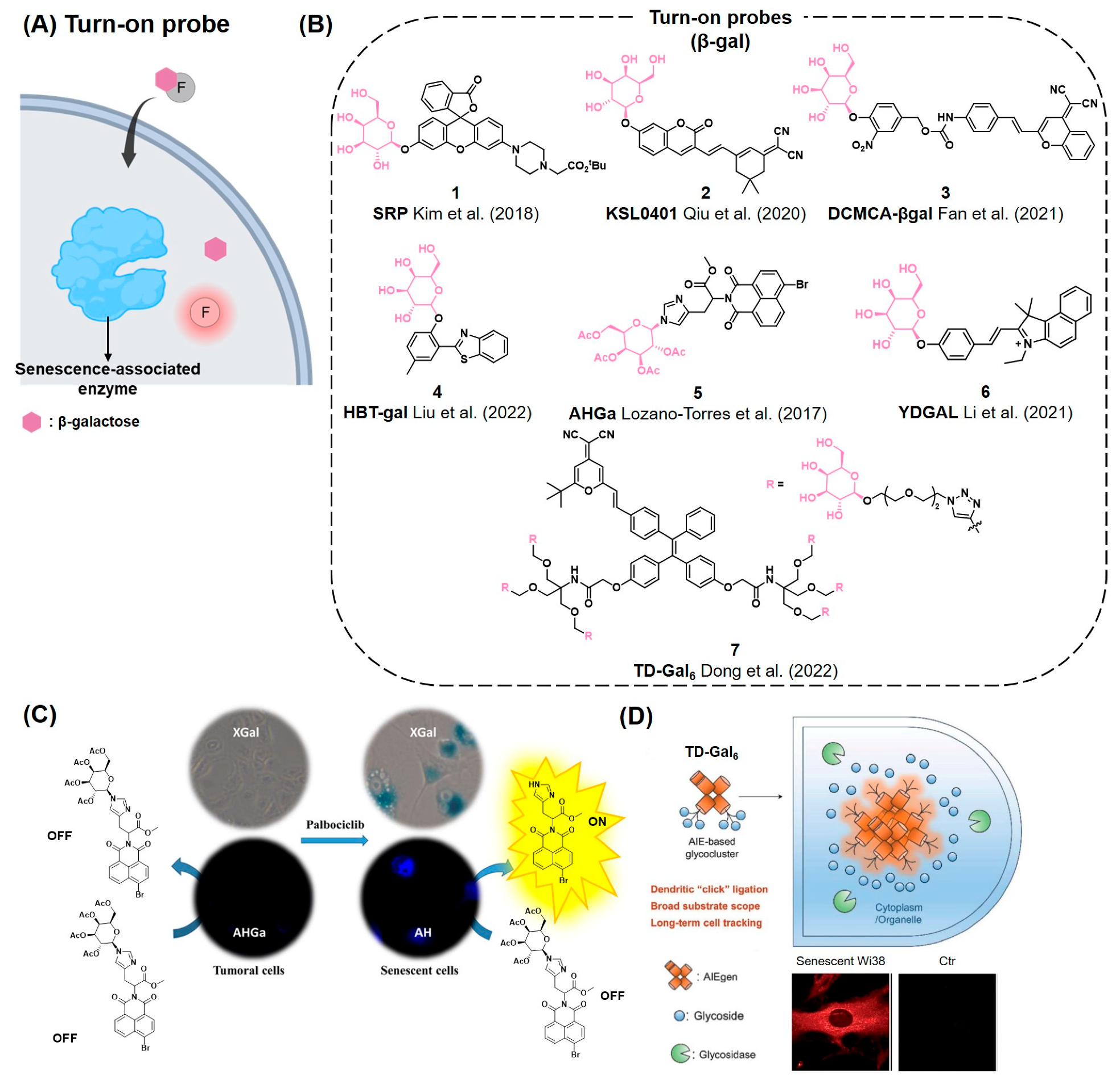
SA-β-gal Ratiometric Fluorescence Probe
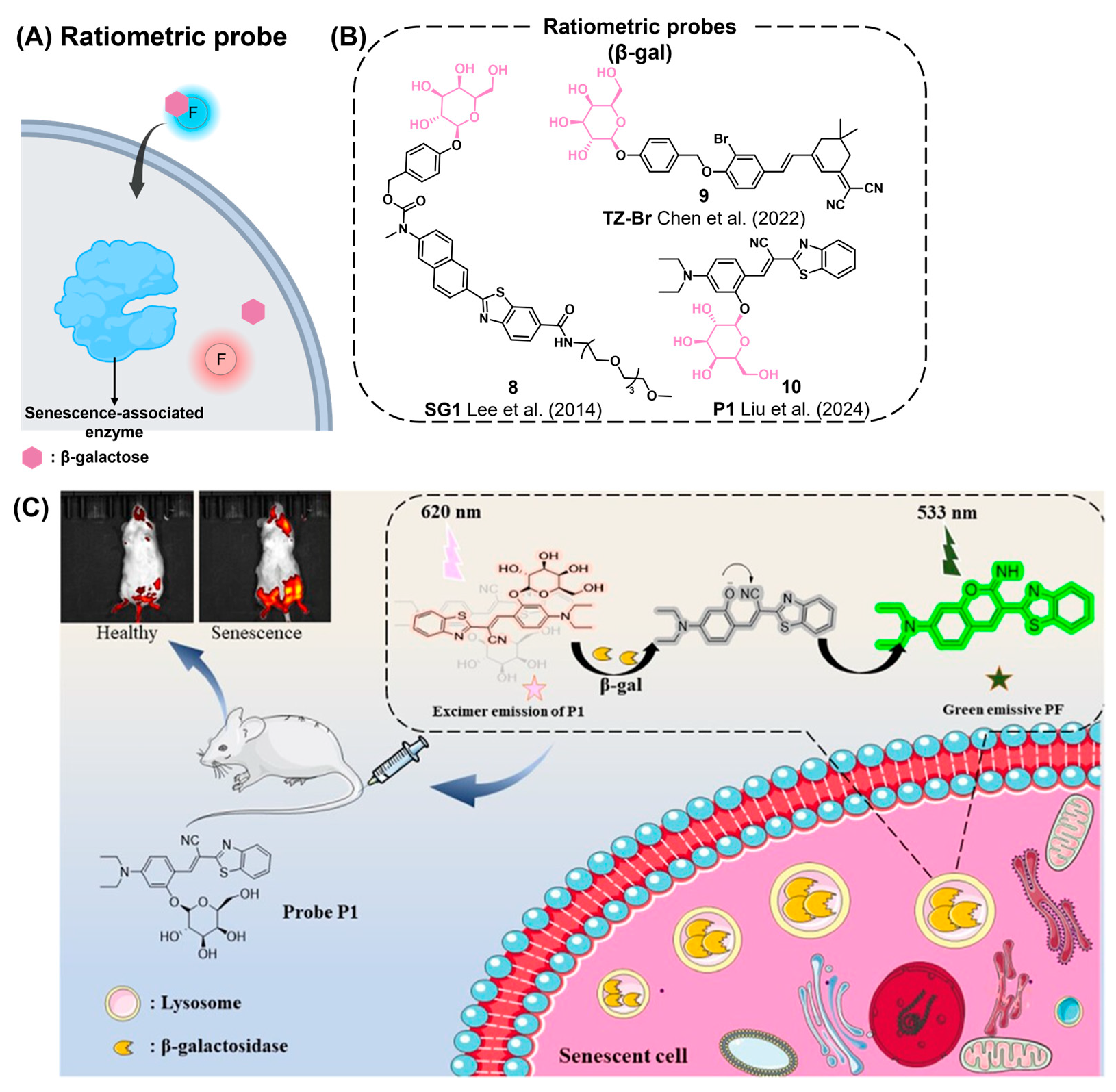
In Situ Covalent Labeling of SA-β-gal Fluorescence Probes
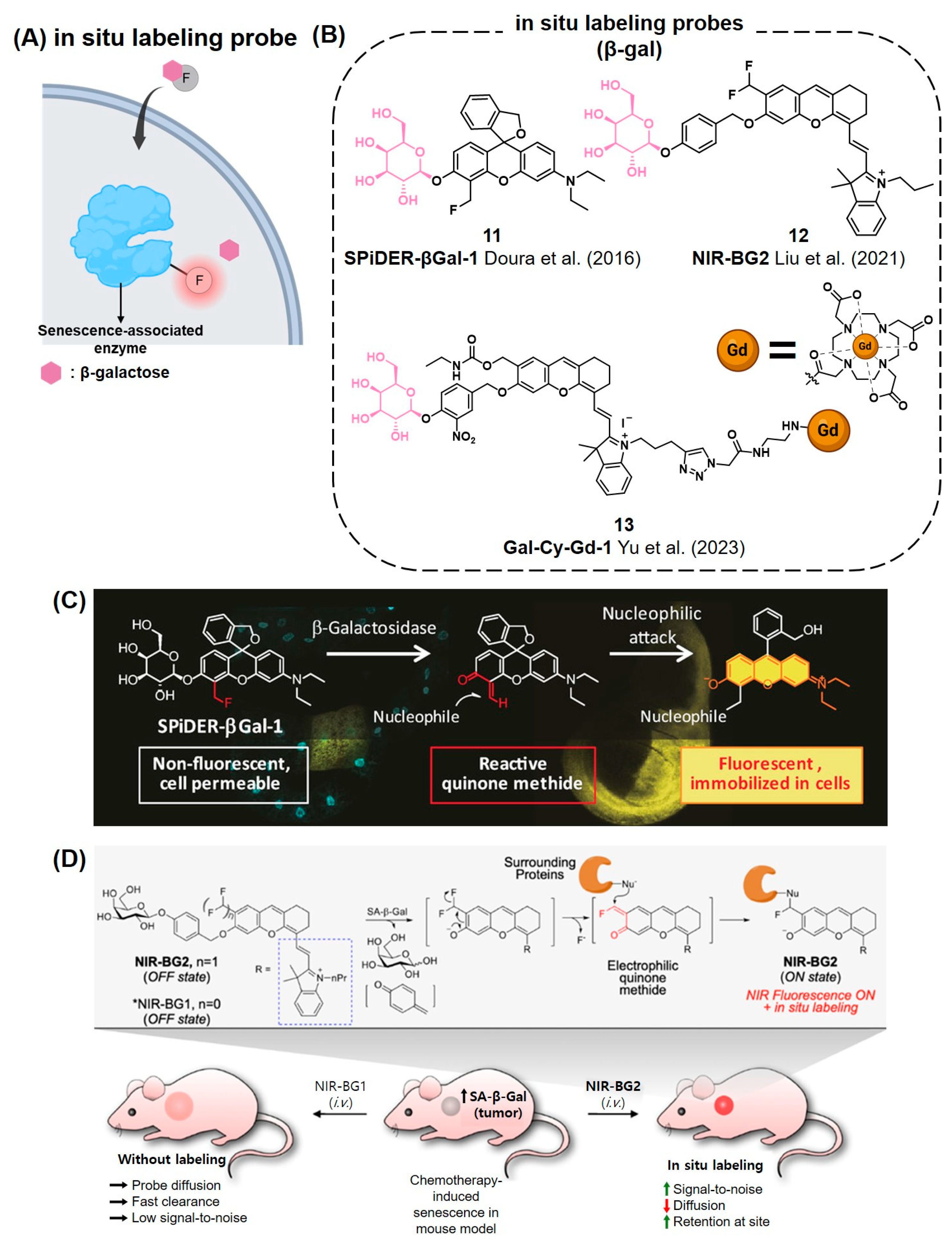
3.2.2. Senescence-Associated α-fucosidase (SA-α-fuc)
3.2.3. Monoamine Oxidases (MAOs)
3.2.4. Sialidase

3.2.5. Acetylcholinesterase
3.3. Small Fluorescence Probes Monitoring Senescence-Associated Subcellular Environment
3.3.1. Lysosomal Polarity
3.3.2. Mitochondria Membrane Potential
3.3.3. Accumulation of Lipids and Protein Aggregations
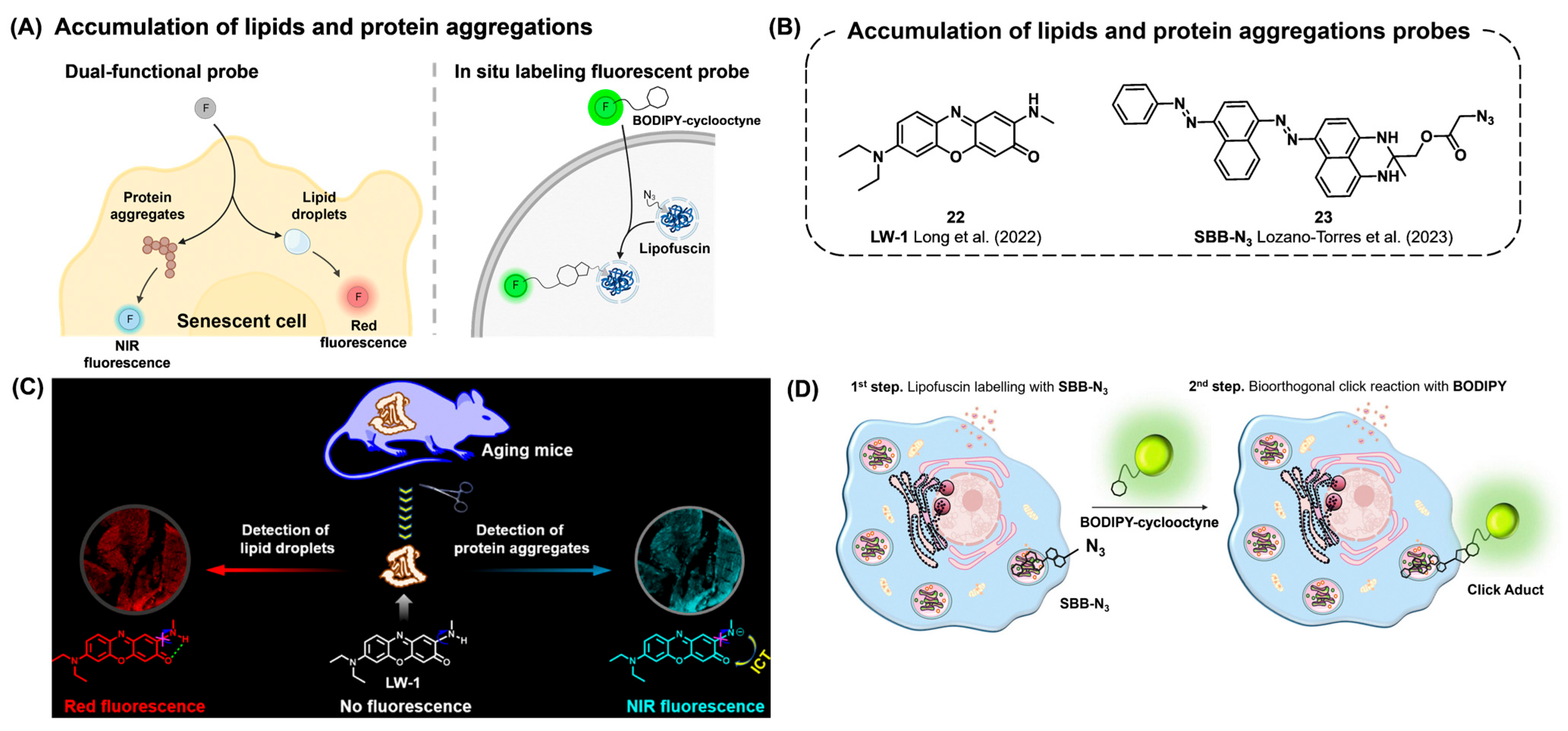
3.4. Small Fluorescence Probes Detecting Senescence-Associated ROS
3.5. Multi-Biomarker-Targeting Fluorescent Probes
3.6. Pros and Cons of Small-Molecule Fluorescent Probes for Cellular Senescence
4. Conclusions and Perspective
Author Contributions
Funding
Institutional Review Board Statement
Informed Consent Statement
Data Availability Statement
Acknowledgments
Conflicts of Interest
References
- Pellegata, N.S.; Antoniono, R.J.; Redpath, J.L.; Stanbridge, E.J. DNA damage and p53-mediated cell cycle arrest: A reevaluation. Proc. Natl. Acad. Sci. USA 1996, 93, 15209–15214. [Google Scholar] [CrossRef] [PubMed]
- Perry, M.E.; Levine, A.J. Tumor-suppressor p53 and the cell cycle. Curr. Opin. Genet. Dev. 1993, 3, 50–54. [Google Scholar] [CrossRef]
- Hayflick, L.; Moorhead, P.S. The serial cultivation of human diploid cell strains. Exp. Cell Res. 1961, 25, 585–621. [Google Scholar] [CrossRef]
- Kuilman, T.; Michaloglou, C.; Vredeveld, L.C.; Douma, S.; van Doorn, R.; Desmet, C.J.; Aarden, L.A.; Mooi, W.J.; Peeper, D.S. Oncogene-induced senescence relayed by an interleukin-dependent inflammatory network. Cell 2008, 133, 1019–1031. [Google Scholar] [CrossRef]
- Acosta, J.C.; O’Loghlen, A.; Banito, A.; Guijarro, M.V.; Augert, A.; Raguz, S.; Fumagalli, M.; Da Costa, M.; Brown, C.; Popov, N.; et al. Chemokine signaling via the CXCR2 receptor reinforces senescence. Cell 2008, 133, 1006–1018. [Google Scholar] [CrossRef]
- Binet, R.; Ythier, D.; Robles, A.I.; Collado, M.; Larrieu, D.; Fonti, C.; Brambilla, E.; Brambilla, C.; Serrano, M.; Harris, C.C. WNT16B is a new marker of cellular senescence that regulates p53 activity and the phosphoinositide 3-kinase/AKT pathway. Cancer Res. 2009, 69, 9183–9191. [Google Scholar] [CrossRef]
- Yoshimoto, S.; Loo, T.M.; Atarashi, K.; Kanda, H.; Sato, S.; Oyadomari, S.; Iwakura, Y.; Oshima, K.; Morita, H.; Hattori, M.; et al. Obesity-induced gut microbial metabolite promotes liver cancer through senescence secretome. Nature 2013, 499, 97–101. [Google Scholar] [CrossRef] [PubMed]
- Childs, B.G.; Baker, D.J.; Wijshake, T.; Conover, C.A.; Campisi, J.; Van Deursen, J.M. Senescent intimal foam cells are deleterious at all stages of atherosclerosis. Science 2016, 354, 472–477. [Google Scholar] [CrossRef] [PubMed]
- Huang, W.; Hickson, L.J.; Eirin, A.; Kirkland, J.L.; Lerman, L.O. Cellular senescence: The good, the bad and the unknown. Nat. Rev. Nephrol. 2022, 18, 611–627. [Google Scholar] [CrossRef]
- McHugh, D.; Gil, J. Senescence and aging: Causes, consequences, and therapeutic avenues. J. Cell Biol. 2018, 217, 65–77. [Google Scholar] [CrossRef]
- Peng, N.; Kang, H.H.; Feng, Y.; Minikes, A.M.; Jiang, X. Autophagy inhibition signals through senescence to promote tumor suppression. Autophagy 2023, 19, 1764–1780. [Google Scholar] [CrossRef] [PubMed]
- Nehlin, J.O. Biomarkers of replicative senescence revisited. In Cellular Ageing and Replicative Senescence; Rattan, S.I.S., Hayflick, L., Eds.; Springer International Publishing: Cham, Switzerland, 2016; pp. 203–239. [Google Scholar]
- Gil, J. The challenge of identifying senescent cells. Nat. Cell Biol. 2023, 25, 1554–1556. [Google Scholar] [CrossRef] [PubMed]
- Horwitz, J.P.; Chua, J.; Curby, R.J.; Tomson, A.J.; Da Rooge, M.A.; Fisher, B.E.; Mauricio, J.; Klundt, I. Substrates for cytochemical demonstration of enzyme activity. I. Some substituted 3-indolyl-β-D-glycopyranosides1a. J. Med. Chem. 1964, 7, 574–575. [Google Scholar] [CrossRef] [PubMed]
- Gatenby, J.B.; Moussa, T.A. The sudan black B technique in cytology. J. R. Microsc. Soc. 1949, 69, 72–75. [Google Scholar] [CrossRef] [PubMed]
- Iourov, I.Y. Quantitative Fluorescence In Situ Hybridization (QFISH). Methods Mol. Biol. 2017, 1541, 143–149. [Google Scholar] [PubMed]
- Giatromanolaki, A.; Kouroupi, M.; Balaska, K.; Koukourakis, M.I. Immunohistochemical detection of senescence markers in human sarcomas. Pathol. Res. Pract. 2020, 216, 152800. [Google Scholar] [CrossRef]
- Lozano-Torres, B.; Galiana, I.; Rovira, M.; Garrido, E.; Chaib, S.; Bernardos, A.; Munoz-Espin, D.; Serrano, M.; Martinez-Manez, R.; Sancenon, F. An OFF–ON two-photon fluorescent probe for tracking cell senescence in vivo. J. Am. Chem. Soc. 2017, 139, 8808–8811. [Google Scholar] [CrossRef]
- Li, Z.; Cheng, J.; Huang, L.; Li, W.; Zhao, Y.; Lin, W. Aging Diagnostic Probe for Research on Aging and Evaluation of Anti-aging Drug Efficacy. Anal. Chem. 2021, 93, 13800–13806. [Google Scholar] [CrossRef]
- Liu, C.; Mei, Y.; Yang, H.; Zhang, Q.; Zheng, K.; Zhang, P.; Ding, C. Ratiometric Fluorescent Probe for Real-Time Detection of beta-Galactosidase Activity in Lysosomes and Its Application in Drug-Induced Senescence Imaging. Anal. Chem. 2024, 96, 3223–3232. [Google Scholar]
- Koo, S.; Won, M.; Li, H.; Kim, W.Y.; Li, M.; Yan, C.; Sharma, A.; Guo, Z.; Zhu, W.H.; Sessler, J.L.; et al. Harnessing alpha-l-fucosidase for in vivo cellular senescence imaging. Chem. Sci. 2021, 12, 10054–10062. [Google Scholar] [CrossRef]
- Shan, Y.M.; Yu, K.K.; Wang, N.; Yu, F.Y.; Li, K.; Liu, Y.H.; Yu, X.Q. Assessing ClO-level during ER stress and cellular senescence through a ratio fluorescent probe with dual organelle targeting ability. Sens. Actuators B Chem. 2022, 358, 131383. [Google Scholar] [CrossRef]
- Huang, P.; Li, Z.; Nong, L.; Cheng, J.; Lin, W. A therapeutic probe for detecting and inhibiting ONOO− in senescent cells. J. Mater. Chem. B 2023, 11, 2389–2396. [Google Scholar] [CrossRef] [PubMed]
- Fu, Y.; Finney, N.S. Small-molecule fluorescent probes and their design. RSC Adv. 2018, 8, 29051–29061. [Google Scholar] [CrossRef] [PubMed]
- Brauer, E.; Lange, T.; Keller, D.; Gorlitz, S.; Cho, S.; Keye, J.; Gossen, M.; Petersen, A.; Kornak, U. Dissecting the influence of cellular senescence on cell mechanics and extracellular matrix formation in vitro. Aging Cell 2023, 22, e13744. [Google Scholar] [CrossRef]
- Lengefeld, J.; Cheng, C.-W.; Maretich, P.; Blair, M.; Hagen, H.; McReynolds, M.R.; Sullivan, E.; Majors, K.; Roberts, C.; Kang, J.H. Cell size is a determinant of stem cell potential during aging. Sci. Adv. 2021, 7, eabk0271. [Google Scholar] [CrossRef]
- Liu, X.; Yan, J.; Kirschner, M.W. Cell size homeostasis is tightly controlled throughout the cell cycle. PLoS Biol. 2024, 22, e3002453. [Google Scholar] [CrossRef]
- Tan, C.; Ginzberg, M.B.; Webster, R.; Iyengar, S.; Liu, S.; Papadopoli, D.; Concannon, J.; Wang, Y.; Auld, D.S.; Jenkins, J.L. Cell size homeostasis is maintained by CDK4-dependent activation of p38 MAPK. Dev. Cell 2021, 56, 1756–1769.e1757. [Google Scholar] [CrossRef] [PubMed]
- Neurohr, G.E.; Terry, R.L.; Lengefeld, J.; Bonney, M.; Brittingham, G.P.; Moretto, F.; Miettinen, T.P.; Vaites, L.P.; Soares, L.M.; Paulo, J.A.; et al. Excessive Cell Growth Causes Cytoplasm Dilution and Contributes to Senescence. Cell 2019, 176, 1083–1097. [Google Scholar] [CrossRef]
- Höhn, A.; Jung, T.; Grimm, S.; Grune, T. Lipofuscin-bound iron is a major intracellular source of oxidants: Role in senescent cells. Free Radic. Biol. Med. 2010, 48, 1100–1108. [Google Scholar] [CrossRef]
- Aravinthan, A.; Verma, S.; Coleman, N.; Davies, S.; Allison, M.; Alexander, G. Vacuolation in hepatocyte nuclei is a marker of senescence. J. Clin. Pathol. 2012, 65, 557–560. [Google Scholar] [CrossRef]
- Lian, X.J.; Gallouzi, I.E. Oxidative Stress Increases the Number of Stress Granules in Senescent Cells and Triggers a Rapid Decrease in p21waf1/cip1 Translation. J. Biol. Chem. 2009, 284, 8877–8887. [Google Scholar] [CrossRef] [PubMed]
- Zou, Y.; Sfeir, A.; Gryaznov, S.M.; Shay, J.W.; Wright, W.E. Does a sentinel or a subset of short telomeres determine replicative senescence? Mol. Biol. Cell 2004, 15, 3709–3718. [Google Scholar] [CrossRef]
- Bernadotte, A.; Mikhelson, V.M.; Spivak, I.M. Markers of cellular senescence. Telomere shortening as a marker of cellular senescence. Aging 2016, 8, 3–11. [Google Scholar] [CrossRef] [PubMed]
- Moyzis, R.K.; Buckingham, J.M.; Cram, L.S.; Dani, M.; Deaven, L.L.; Jones, M.D.; Meyne, J.; Ratliff, R.L.; Wu, J.-R. A highly conserved repetitive DNA sequence, (TTAGGG) n, present at the telomeres of human chromosomes. Proc. Natl. Acad. Sci. USA 1988, 85, 6622–6626. [Google Scholar] [CrossRef] [PubMed]
- Harley, C.B.; Futcher, A.B.; Greider, C.W. Telomeres shorten during ageing of human fibroblasts. Nature 1990, 345, 458–460. [Google Scholar] [CrossRef] [PubMed]
- Allsopp, R.C.; Chang, E.; Kashefi-Aazam, M.; Rogaev, E.I.; Piatyszek, M.A.; Shay, J.W.; Harley, C.B. Telomere shortening is associated with cell division in vitro and in vivo. Exp. Cell Res. 1995, 220, 194–200. [Google Scholar] [CrossRef] [PubMed]
- Hayflick, L. The limited in vitro lifetime of human diploid cell strains. Exp. Cell Res. 1965, 37, 614–636. [Google Scholar] [CrossRef] [PubMed]
- Greider, C.W.; Blackburn, E.H. A telomeric sequence in the RNA of Tetrahymena telomerase required for telomere repeat synthesis. Nature 1989, 337, 331–337. [Google Scholar] [CrossRef] [PubMed]
- Bloom, J.; Cross, F.R. Multiple levels of cyclin specificity in cell-cycle control. Nat. Rev. Mol. Cell Biol. 2007, 8, 149–160. [Google Scholar] [CrossRef]
- Malumbres, M.; Barbacid, M. Cell cycle, CDKs and cancer: A changing paradigm. Nat. Rev. Cancer 2009, 9, 153–166. [Google Scholar] [CrossRef]
- Orlando, D.A.; Lin, C.Y.; Bernard, A.; Wang, J.Y.; Socolar, J.E.; Iversen, E.S.; Hartemink, A.J.; Haase, S.B. Global control of cell-cycle transcription by coupled CDK and network oscillators. Nature 2008, 453, 944–947. [Google Scholar] [CrossRef] [PubMed]
- Serrano, M.; Lin, A.W.; McCurrach, M.E.; Beach, D.; Lowe, S.W. Oncogenic ras provokes premature cell senescence associated with accumulation of p53 and p16INK4a. Cell 1997, 88, 593–602. [Google Scholar] [CrossRef] [PubMed]
- Alcorta, D.A.; Xiong, Y.; Phelps, D.; Hannon, G.; Beach, D.; Barrett, J.C. Involvement of the cyclin-dependent kinase inhibitor p16 (INK4a) in replicative senescence of normal human fibroblasts. Proc. Natl. Acad. Sci. USA 1996, 93, 13742–13747. [Google Scholar] [CrossRef] [PubMed]
- Xu, R.; Garcia-Barros, M.; Wen, S.; Li, F.; Lin, C.L.; Hannun, Y.A.; Obeid, L.M.; Mao, C. Tumor suppressor p53 links ceramide metabolism to DNA damage response through alkaline ceramidase 2. Cell Death Differ. 2018, 25, 841–856. [Google Scholar] [CrossRef] [PubMed]
- Rayess, H.; Wang, M.B.; Srivatsan, E.S. Cellular senescence and tumor suppressor gene p16. Int. J. Cancer 2012, 130, 1715–1725. [Google Scholar] [CrossRef] [PubMed]
- Sherr, C.J. The INK4a/ARF network in tumour suppression. Nat. Rev. Mol. Cell Biol. 2001, 2, 731–737. [Google Scholar] [CrossRef] [PubMed]
- Rocha, A.; Dalgarno, A.; Neretti, N. The functional impact of nuclear reorganization in cellular senescence. Brief. Funct. Genom. 2022, 21, 24–34. [Google Scholar] [CrossRef] [PubMed]
- Liu, J.; Cai, S.-Z.; Zhou, Y.; Zhang, X.-P.; Liu, D.-F.; Jiang, R.; Wang, Y.-P. Senescence as A Consequence of Ginsenoside Rg 1 Response on K562 Human Leukemia Cell Line. Asian. Pac. J. Cancer Prev. 2012, 13, 6191–6196. [Google Scholar] [CrossRef] [PubMed]
- Li, W.; Kawaguchi, K.; Tanaka, S.; He, C.; Maeshima, Y.; Suzuki, E.; Toi, M. Cellular senescence triggers intracellular acidification and lysosomal pH alkalinized via ATP6AP2 attenuation in breast cancer cells. Commun. Biol. 2023, 6, 1147. [Google Scholar] [CrossRef]
- Rovira, M.; Sereda, R.; Pladevall-Morera, D.; Ramponi, V.; Marin, I.; Maus, M.; Madrigal-Matute, J.; Diaz, A.; Garcia, F.; Munoz, J.; et al. The lysosomal proteome of senescent cells contributes to the senescence secretome. Aging Cell 2022, 21, e13707. [Google Scholar] [CrossRef]
- Curnock, R.; Yalci, K.; Palmfeldt, J.; Jäättelä, M.; Liu, B.; Carroll, B. TFEB-dependent lysosome biogenesis is required for senescence. EMBO J. 2023, 42, e111241. [Google Scholar] [CrossRef] [PubMed]
- Borodkina, A.; Shatrova, A.; Abushik, P.; Nikolsky, N.; Burova, E. Interaction between ROS dependent DNA damage, mitochondria and p38 MAPK underlies senescence of human adult stem cells. Aging 2014, 6, 481. [Google Scholar] [CrossRef] [PubMed]
- Passos, J.F.; Nelson, G.; Wang, C.; Richter, T.; Simillion, C.; Proctor, C.J.; Miwa, S.; Olijslagers, S.; Hallinan, J.; Wipat, A. Feedback between p21 and reactive oxygen production is necessary for cell senescence. Mol. Syst. Biol. 2010, 6, 347. [Google Scholar] [CrossRef] [PubMed]
- Kauppila, T.E.S.; Kauppila, J.H.K.; Larsson, N.G. Mammalian Mitochondria and Aging: An Update. Cell Metab. 2017, 25, 57–71. [Google Scholar] [CrossRef] [PubMed]
- Li, Y.; Tian, X.; Luo, J.; Bao, T.; Wang, S.; Wu, X. Molecular mechanisms of aging and anti-aging strategies. Cell Commun. Signal. 2024, 22, 285. [Google Scholar] [CrossRef]
- Lee, B.Y.; Han, J.A.; Im, J.S.; Morrone, A.; Johung, K.; Goodwin, E.C.; Kleijer, W.J.; DiMaio, D.; Hwang, E.S. Senescence-associated β-galactosidase is lysosomal β-galactosidase. Aging Cell 2006, 5, 187–195. [Google Scholar] [CrossRef] [PubMed]
- Dimri, G.P.; Lee, X.; Basile, G.; Acosta, M.; Scott, G.; Roskelley, C.; Medrano, E.E.; Linskens, M.; Rubelj, I.; Pereira-Smith, O. A biomarker that identifies senescent human cells in culture and in aging skin in vivo. Proc. Natl. Acad. Sci. USA 1995, 92, 9363–9367. [Google Scholar] [CrossRef] [PubMed]
- Yang, N.C.; Hu, M.L. The limitations and validities of senescence associated-beta-galactosidase activity as an aging marker for human foreskin fibroblast Hs68 cells. Exp. Gerontol. 2005, 40, 813–819. [Google Scholar] [CrossRef]
- Hildebrand, D.; Lehle, S.; Borst, A.; Haferkamp, S.; Essmann, F.; Schulze-Osthoff, K. α-Fucosidase as a novel convenient biomarker for cellular senescence. Cell Cycle 2013, 12, 1922–1927. [Google Scholar] [CrossRef]
- Santin, Y.; Resta, J.; Parini, A.; Mialet-Perez, J. Monoamine oxidases in age-associated diseases: New perspectives for old enzymes. Ageing Res. Rev. 2021, 66, 101256. [Google Scholar] [CrossRef]
- Anderson, R.; Lagnado, A.; Maggiorani, D.; Walaszczyk, A.; Dookun, E.; Chapman, J.; Birch, J.; Salmonowicz, H.; Ogrodnik, M.; Jurk, D.; et al. Length-independent telomere damage drives post-mitotic cardiomyocyte senescence. EMBO J. 2019, 38, e100492. [Google Scholar] [CrossRef]
- Passos, J.F.; Saretzki, G.; Ahmed, S.; Nelson, G.; Richter, T.; Peters, H.; Wappler, I.; Birket, M.J.; Harold, G.; Schaeuble, K. Mitochondrial dysfunction accounts for the stochastic heterogeneity in telomere-dependent senescence. PLoS Biol. 2007, 5, e110. [Google Scholar] [CrossRef] [PubMed]
- Zhou, D.; Shao, L.; Spitz, D.R. Reactive oxygen species in normal and tumor stem cells. Adv. Cancer Res. 2014, 122, 1–67. [Google Scholar] [PubMed]
- Victorelli, S.; Passos, J.F. Reactive Oxygen Species Detection in Senescent Cells. Methods Mol. Biol. 2019, 1896, 21–29. [Google Scholar] [PubMed]
- Fan, L.M.; Li, J.M. Evaluation of methods of detecting cell reactive oxygen species production for drug screening and cell cycle studies. J. Pharmacol. Toxicol. Methods 2014, 70, 40–47. [Google Scholar] [CrossRef] [PubMed]
- Liu, X.L.; Ding, J.; Meng, L.H. Oncogene-induced senescence: A double edged sword in cancer. Acta Pharmacol. Sin. 2018, 39, 1553–1558. [Google Scholar] [CrossRef]
- De Mera-Rodríguez, J.A.; Álvarez-Hernán, G.; Gañán, Y.; Martín-Partido, G.; Rodríguez-León, J.; Francisco-Morcillo, J. Is senescence-associated β-galactosidase a reliable in vivo marker of cellular senescence during embryonic development? Front. Cell Dev. Biol. 2021, 9, 623175. [Google Scholar] [CrossRef]
- Burn, S.F. Detection of beta-galactosidase activity: X-gal staining. Methods Mol. Biol. 2012, 886, 241–250. [Google Scholar]
- Lederberg, J. The beta-d-galactosidase of Escherichia coli, strain K-12. J. Bacteriol. 1950, 60, 381–392. [Google Scholar] [CrossRef]
- Jung, T.; Hohn, A.; Grune, T. Lipofuscin: Detection and quantification by microscopic techniques. Methods Mol. Biol. 2010, 594, 173–193. [Google Scholar]
- Evangelou, K.; Gorgoulis, V.G. Sudan Black B, The Specific Histochemical Stain for Lipofuscin: A Novel Method to Detect Senescent Cells. Methods Mol. Biol. 2017, 1534, 111–119. [Google Scholar]
- Evangelou, K.; Lougiakis, N.; Rizou, S.V.; Kotsinas, A.; Kletsas, D.; Munoz-Espin, D.; Kastrinakis, N.G.; Pouli, N.; Marakos, P.; Townsend, P.; et al. Robust, universal biomarker assay to detect senescent cells in biological specimens. Aging Cell 2017, 16, 192–197. [Google Scholar] [CrossRef]
- Lozano-Torres, B.; Estepa-Fernández, A.; Rovira, M.; Orzaez, M.; Serrano, M.; Martinez-Manez, R.; Sancenon, F. The chemistry of senescence. Nat. Rev. Chem. 2019, 3, 426–441. [Google Scholar] [CrossRef]
- Kumari, R.; Jat, P. Mechanisms of Cellular Senescence: Cell Cycle Arrest and Senescence Associated Secretory Phenotype. Front. Cell Dev. Biol. 2021, 9, 645593. [Google Scholar] [CrossRef]
- Kastenhuber, E.R.; Lowe, S.W. Putting p53 in Context. Cell 2017, 170, 1062–1078. [Google Scholar] [CrossRef] [PubMed]
- Mansour, M.A.; Rahman, M.; Ayad, A.A.; Warrington, A.E.; Burns, T.C. P21 overexpression promotes cell death and induces senescence in human glioblastoma. Cancers 2023, 15, 1279. [Google Scholar] [CrossRef] [PubMed]
- Safwan-Zaiter, H.; Wagner, N.; Wagner, K.-D. P16INK4A—More Than a Senescence Marker. Life 2022, 12, 1332. [Google Scholar] [CrossRef]
- Kamal, N.S.M.; Safuan, S.; Shamsuddin, S.; Foroozandeh, P. Aging of the cells: Insight into cellular senescence and detection Methods. Eur. J. Cell Biol. 2020, 99, 151108. [Google Scholar] [CrossRef] [PubMed]
- Mijit, M.; Caracciolo, V.; Melillo, A.; Amicarelli, F.; Giordano, A. Role of p53 in the Regulation of Cellular Senescence. Biomolecules 2020, 10, 420. [Google Scholar] [CrossRef]
- Park, M.H.; Choi, J.E.; Kim, J.R.; Bae, Y.K. Immunohistochemical Expressions of Senescence-Associated Secretory Phenotype and Its Association with Immune Microenvironments and Clinicopathological Factors in Invasive Breast Cancer. Pathol. Oncol. Res. 2021, 27, 1609795. [Google Scholar] [CrossRef]
- Herrmann, J.; Babic, M.; Tolle, M.; Eckardt, K.U.; van der Giet, M.; Schuchardt, M. A Novel Protocol for Detection of Senescence and Calcification Markers by Fluorescence Microscopy. Int. J. Mol. Sci. 2020, 21, 3475. [Google Scholar] [CrossRef] [PubMed]
- Ourliac-Garnier, I.; Londono-Vallejo, A. Telomere length analysis by quantitative fluorescent in situ hybridization (Q-FISH). Methods Mol. Biol. 2011, 735, 21–31. [Google Scholar] [PubMed]
- Langer-Safer, P.R.; Levine, M.; Ward, D.C. Immunological method for mapping genes on Drosophila polytene chromosomes. Proc. Natl. Acad. Sci. USA 1982, 79, 4381–4385. [Google Scholar] [CrossRef] [PubMed]
- Kim, E.-J.; Podder, A.; Maiti, M.; Lee, J.M.; Chung, B.G.; Bhuniya, S. Selective monitoring of vascular cell senescence via β-galactosidase detection with a fluorescent chemosensor. Sens. Actuators B Chem. 2018, 274, 194–200. [Google Scholar] [CrossRef]
- Qiu, W.; Li, X.; Shi, D.; Li, X.; Gao, Y.; Li, J.; Mao, F.; Guo, Y.; Li, J. A rapid-response near-infrared fluorescent probe with a large Stokes shift for senescence-associated β-galactosidase activity detection and imaging of senescent cells. Dye. Pigment. 2020, 182, 108657. [Google Scholar] [CrossRef]
- Fan, F.; Zhang, L.; Zhou, X.; Mu, F.; Shi, G. A sensitive fluorescent probe for beta-galactosidase activity detection and application in ovarian tumor imaging. J. Mater. Chem. B 2021, 9, 170–175. [Google Scholar] [CrossRef] [PubMed]
- Guo, Z.; Zhu, W.; Tian, H. Dicyanomethylene-4H-pyran chromophores for OLED emitters, logic gates and optical chemosensors. Chem. Commun. 2012, 48, 6073–6084. [Google Scholar] [CrossRef] [PubMed]
- Wu, X.; Sun, X.; Guo, Z.; Tang, J.; Shen, Y.; James, T.D.; Tian, H.; Zhu, W. In vivo and in situ tracking cancer chemotherapy by highly photostable NIR fluorescent theranostic prodrug. J. Am. Chem. Soc. 2014, 136, 3579–3588. [Google Scholar] [CrossRef]
- Gu, K.; Liu, Y.; Guo, Z.; Lian, C.; Yan, C.; Shi, P.; Tian, H.; Zhu, W.H. In Situ Ratiometric Quantitative Tracing of Intracellular Leucine Aminopeptidase Activity via an Activatable Near-Infrared Fluorescent Probe. ACS Appl. Mater. Interfaces 2016, 8, 26622–26629. [Google Scholar] [CrossRef]
- Liu, D.; Zhang, Z.; Chen, A.; Zhang, P. A turn on fluorescent assay for real time determination of beta-galactosidase and its application in living cell imaging. Spectrochim. Acta A Mol. Biomol. Spectrosc. 2022, 265, 120345. [Google Scholar] [CrossRef]
- Bush, P.G.; Wokosin, D.L.; Hall, A.C. Two-versus one photon excitation laser scanning microscopy: Critical importance of excitation wavelength. Front. Biosci. 2007, 12, 2646–2657. [Google Scholar] [CrossRef]
- Squirrell, J.M.; Wokosin, D.L.; White, J.G.; Bavister, B.D. Long-term two-photon fluorescence imaging of mammalian embryos without compromising viability. Nat. Biotechnol. 1999, 17, 763–767. [Google Scholar] [CrossRef]
- Luo, J.; Xie, Z.; Lam, J.W.; Cheng, L.; Chen, H.; Qiu, C.; Kwok, H.S.; Zhan, X.; Liu, Y.; Zhu, D.; et al. Aggregation-induced emission of 1-methyl-1,2,3,4,5-pentaphenylsilole. Chem. Commun. 2001, 18, 1740–1741. [Google Scholar] [CrossRef]
- Zhu, C.; Kwok, R.T.K.; Lam, J.W.Y.; Tang, B.Z. Aggregation-Induced Emission: A Trailblazing Journey to the Field of Biomedicine. ACS Appl. Bio Mater. 2018, 1, 1768–1786. [Google Scholar] [CrossRef]
- Dong, L.; Zhang, M.Y.; Han, H.H.; Zang, Y.; Chen, G.R.; Li, J.; He, X.P.; Vidal, S. A general strategy to the intracellular sensing of glycosidases using AIE-based glycoclusters. Chem. Sci. 2021, 13, 247–256. [Google Scholar] [CrossRef]
- Chai, X.; Han, H.H.; Sedgwick, A.C.; Li, N.; Zang, Y.; James, T.D.; Zhang, J.; Hu, X.L.; Yu, Y.; Li, Y.; et al. Photochromic Fluorescent Probe Strategy for the Super-resolution Imaging of Biologically Important Biomarkers. J. Am. Chem. Soc. 2020, 142, 18005–18013. [Google Scholar] [CrossRef]
- Park, S.H.; Kwon, N.; Lee, J.H.; Yoon, J.; Shin, I. Synthetic ratiometric fluorescent probes for detection of ions. Chem. Soc. Rev. 2020, 49, 143–179. [Google Scholar] [CrossRef]
- Lee, H.W.; Heo, C.H.; Sen, D.; Byun, H.O.; Kwak, I.H.; Yoon, G.; Kim, H.M. Ratiometric two-photon fluorescent probe for quantitative detection of beta-galactosidase activity in senescent cells. Anal. Chem. 2014, 86, 10001–10005. [Google Scholar] [CrossRef]
- Chen, S.; Wang, L.; Ma, X.; Wu, Y.; Hou, S. Kill two birds with one stone: A near-infrared ratiometric fluorescent probe for simultaneous detection of β-galactosidase in senescent and cancer cells. Sens. Actuators B Chem. 2022, 367, 132061. [Google Scholar] [CrossRef]
- Doura, T.; Kamiya, M.; Obata, F.; Yamaguchi, Y.; Hiyama, T.Y.; Matsuda, T.; Fukamizu, A.; Noda, M.; Miura, M.; Urano, Y. Detection of LacZ-Positive Cells in Living Tissue with Single-Cell Resolution. Angew. Chem. Int. Ed. Engl. 2016, 55, 9620–9624. [Google Scholar] [CrossRef]
- Liu, J.; Ma, X.; Cui, C.; Chen, Z.; Wang, Y.; Deenik, P.R.; Cui, L. Noninvasive NIR Imaging of Senescence via In Situ Labeling. J. Med. Chem. 2021, 64, 17969–17978. [Google Scholar] [CrossRef] [PubMed]
- Yu, Q.; Zhang, L.; Jiang, M.; Xiao, L.; Xiang, Y.; Wang, R.; Liu, Z.; Zhou, R.; Yang, M.; Li, C.; et al. An NIR Fluorescence Turn-on and MRl Bimodal Probe for Concurrent Real-time in vivo Sensing and Labeling of beta-Galactosidase. Angew. Chem. Int. Ed. Engl. 2023, 62, e202313137. [Google Scholar] [CrossRef]
- Singh, M.; Piekorz, R.P. Senescence-associated lysosomal alpha-L-fucosidase (SA-alpha-Fuc): A sensitive and more robust biomarker for cellular senescence beyond SA-beta-Gal. Cell Cycle 2013, 12, 1996. [Google Scholar] [CrossRef]
- Jones, D.N.; Raghanti, M.A. The role of monoamine oxidase enzymes in the pathophysiology of neurological disorders. J. Chem. Neuroanat. 2021, 114, 101957. [Google Scholar] [CrossRef] [PubMed]
- Wang, R.; Han, X.; You, J.; Yu, F.; Chen, L. Ratiometric near-infrared fluorescent probe for synergistic detection of monoamine oxidase B and its contribution to oxidative stress in cell and mice aging models. Anal. Chem. 2018, 90, 4054–4061. [Google Scholar] [CrossRef]
- Chen, X.; Varki, A. Advances in the biology and chemistry of sialic acids. ACS Chem. Biol. 2010, 5, 163–176. [Google Scholar] [CrossRef]
- Schmidt, C.; Stehling, P.; Schnitzer, J.; Reutter, W.; Horstkorte, R.d. Biochemical Engineering of Neural Cell Surfaces by the SyntheticN-Propanoyl-substituted Neuraminic Acid Precursor. J. Biol. Chem. 1998, 273, 19146–19152. [Google Scholar] [CrossRef]
- Durocher, J.R.; Payne, R.C.; Conrad, M.E. Role of sialic acid in erythrocyte survival. Blood 1975, 45, 11–20. [Google Scholar] [CrossRef] [PubMed]
- Landaw, S.A.; Tenforde, T.; Schooley, J.C. Decreased surface charge and accelerated senescence of red blood cells following neuraminidase treatment. J. Lab. Clin. Med. 1977, 89, 581–591. [Google Scholar]
- Zhu, R.; Wang, S.; Xue, Z.; Han, J.; Han, S. Senescence-associated sialidase revealed by an activatable fluorescence-on labeling probe. Chem. Commun. 2018, 54, 11566–11569. [Google Scholar] [CrossRef]
- He, N.; Yu, L.; Xu, M.; Huang, Y.; Wang, X.; Chen, L.; Yue, S. Near-infrared fluorescent probe for evaluating the acetylcholinesterase effect in the aging process and dietary restriction via fluorescence imaging. J. Mater. Chem. B 2021, 9, 2623–2630. [Google Scholar] [CrossRef] [PubMed]
- Shi, D.; Hu, L.; Li, X.; Liu, W.; Gao, Y.; Li, X.; Jiang, B.; Xia, C.; Guo, Y.; Li, J. Lysosomal polarity increases with aging as revealed by a lysosome-targetable near-infrared fluorescent probe. Sens. Actuators B Chem. 2020, 319, 128302. [Google Scholar] [CrossRef]
- Das, S.; Batra, A.; Kundu, S.; Sharma, R.; Patra, A. Unveiling autophagy and aging through time-resolved imaging of lysosomal polarity with a delayed fluorescent emitter. Chem. Sci. 2023, 15, 102–112. [Google Scholar] [CrossRef] [PubMed]
- Ang, J.; Lee, Y.A.; Raghothaman, D.; Jayaraman, P.; Teo, K.L.; Khan, F.J.; Reuveny, S.; Chang, Y.T.; Kang, N.Y.; Oh, S. Rapid detection of senescent mesenchymal stromal cells by a fluorescent probe. Biotechnol. J. 2019, 14, 1800691. [Google Scholar] [CrossRef]
- Tian, X.; Li, J.; Zhang, Y.; Gao, Y.; Afzal, M.W.; Wang, A.; James, T.D.; Bai, Y.; Guo, Y. A spiropyran with low pKa for tracking DNA G-quadruplexes and revealing the dissipation of ΔΨm with senescence using an in-situ switching strategy. Sens. Actuators B Chem. 2022, 359, 131618. [Google Scholar] [CrossRef]
- Cuanalo-Contreras, K.; Schulz, J.; Mukherjee, A.; Park, K.W.; Armijo, E.; Soto, C. Extensive accumulation of misfolded protein aggregates during natural aging and senescence. Front. Aging Neurosci. 2022, 14, 1090109. [Google Scholar] [CrossRef]
- Chen, X.; Chen, K.; Hu, J.; Dong, Y.; Zheng, M.; Jiang, J.; Hu, Q.; Zhang, W. Palmitic acid induces lipid droplet accumulation and senescence in nucleus pulposus cells via ER-stress pathway. Commun. Biol. 2024, 7, 539. [Google Scholar] [CrossRef] [PubMed]
- Long, L.; Liu, W.; Ruan, P.; Yang, X.; Chen, X.; Li, L.; Yuan, F.; He, D.; Huang, P.; Gong, A.; et al. Visualizing the Interplay of Lipid Droplets and Protein Aggregates During Aging via a Dual-Functional Fluorescent Probe. Anal. Chem. 2022, 94, 2803–2811. [Google Scholar] [CrossRef] [PubMed]
- Strehler, B.L.; Mark, D.D.; Mildvan, A.S. Rate and magnitude of age pigment accumulation in the human myocardium. J. Gerontol. 1959, 14, 430–439. [Google Scholar] [CrossRef]
- Sohal, R.S.; Wolfe, L.S. Lipofuscin: Characteristics and significance. Prog. Brain Res. 1986, 70, 171–183. [Google Scholar]
- Lozano-Torres, B.; Blandez, J.F.; García-Fernández, A.; Sancenón, F.; Martínez-Máñez, R. Lipofuscin labeling through biorthogonal strain-promoted azide-alkyne cycloaddition for the detection of senescent cells. FEBS J. 2023, 290, 1314–1325. [Google Scholar] [CrossRef]
- Narayanaswamy, N.; Narra, S.; Nair, R.R.; Saini, D.K.; Kondaiah, P.; Govindaraju, T. Stimuli-responsive colorimetric and NIR fluorescence combination probe for selective reporting of cellular hydrogen peroxide. Chem. Sci. 2016, 7, 2832–2841. [Google Scholar] [CrossRef]
- Dong, X.; Ouyang, H.; Lou, X.; Xia, F.; Jin, L.; Wang, S.; Dai, J. Dual-Activated H2O2-Responsive AIE Probes for Oocyte Quality Assessment. Anal. Chem. 2024, 96, 5960–5967. [Google Scholar] [CrossRef]
- Lee, S.K.; Han, M.S.; Tung, C.H. In vivo senescence imaging nanoprobe targets the associated reactive oxygen species. Nanoscale 2024, 16, 1371–1383. [Google Scholar] [CrossRef]
- Gao, Y.; Hu, Y.; Liu, Q.; Li, X.; Li, X.; Kim, C.Y.; James, T.D.; Li, J.; Chen, X.; Guo, Y. Two-dimensional design strategy to construct smart fluorescent probes for the precise tracking of senescence. Angew. Chem. 2021, 133, 10851–10860. [Google Scholar] [CrossRef]
- Zhou, L.; Zhang, X.; Dong, Y.; Pan, Y.; Li, J.; Zang, Y.; Li, X. A Tandemly Activated Fluorescence Probe for Detecting Senescent Cells with Improved Selectivity by Targeting a Biomarker Combination. ACS Sens. 2022, 7, 1958–1966. [Google Scholar] [CrossRef]
- Li, J.; Wang, L.; Luo, X.; Xia, Y.; Xie, Y.; Liu, Y.; Tan, W. Dual-Parameter Recognition-Directed Design of the Activatable Fluorescence Probe for Precise Imaging of Cellular Senescence. Anal. Chem. 2023, 95, 3996–4004. [Google Scholar] [CrossRef]
- Liu, H.; Lv, R.; Song, F.; Yang, Y.; Zhang, F.; Xin, L.; Zhang, P.; Zhang, Q.; Ding, C. A near-IR ratiometric fluorescent probe for the precise tracking of senescence: A multidimensional sensing assay of biomarkers in cell senescence pathways. Chem. Sci. 2024, 15, 5681–5693. [Google Scholar] [CrossRef]
- Wang, L.; Li, J.; Zhao, Z.; Xia, Y.; Xie, Y.; Hong, D.; Liu, Y.; Tan, W. Aptamer Conjugate-Based Ratiometric Fluorescent Probe for Precise Imaging of Therapy-Induced Cancer Senescence. Anal. Chem. 2024, 96, 154–162. [Google Scholar] [CrossRef]
- Mrazkova, B.; Dzijak, R.; Imrichova, T.; Kyjacova, L.; Barath, P.; Dzubak, P.; Holub, D.; Hajduch, M.; Nahacka, Z.; Andera, L.; et al. Induction, regulation and roles of neural adhesion molecule L1CAM in cellular senescence. Aging 2018, 10, 434–462. [Google Scholar] [CrossRef]
- Gonzalez-Gualda, E.; Baker, A.G.; Fruk, L.; Munoz-Espin, D. A guide to assessing cellular senescence in vitro and in vivo. FEBS J. 2021, 288, 56–80. [Google Scholar] [CrossRef] [PubMed]
- Li, H.-Y.; Wei, T.-T.; Zhuang, M.; Tan, C.-Y.; Xie, T.-H.; Cai, J.; Yao, Y.; Zhu, L. Iron derived from NCOA4-mediated ferritinophagy causes cellular senescence via the cGAS-STING pathway. Cell Death Discov. 2023, 9, 419. [Google Scholar] [CrossRef] [PubMed]
- Masaldan, S.; Clatworthy, S.A.; Gamell, C.; Meggyesy, P.M.; Rigopoulos, A.-T.; Haupt, S.; Haupt, Y.; Denoyer, D.; Adlard, P.A.; Bush, A.I. Iron accumulation in senescent cells is coupled with impaired ferritinophagy and inhibition of ferroptosis. Redox Biol. 2018, 14, 100–115. [Google Scholar] [CrossRef] [PubMed]
- Maus, M.; Lopez-Polo, V.; Mateo, L.; Lafarga, M.; Aguilera, M.; De Lama, E.; Meyer, K.; Sola, A.; Lopez-Martinez, C.; Lopez-Alonso, I.; et al. Iron accumulation drives fibrosis, senescence and the senescence-associated secretory phenotype. Nat. Metab. 2023, 5, 2111–2130. [Google Scholar] [CrossRef]
- Masaldan, S.; Clatworthy, S.A.; Gamell, C.; Smith, Z.M.; Francis, P.S.; Denoyer, D.; Meggyesy, P.M.; La Fontaine, S.; Cater, M.A. Copper accumulation in senescent cells: Interplay between copper transporters and impaired autophagy. Redox Biol. 2018, 16, 322–331. [Google Scholar] [CrossRef]

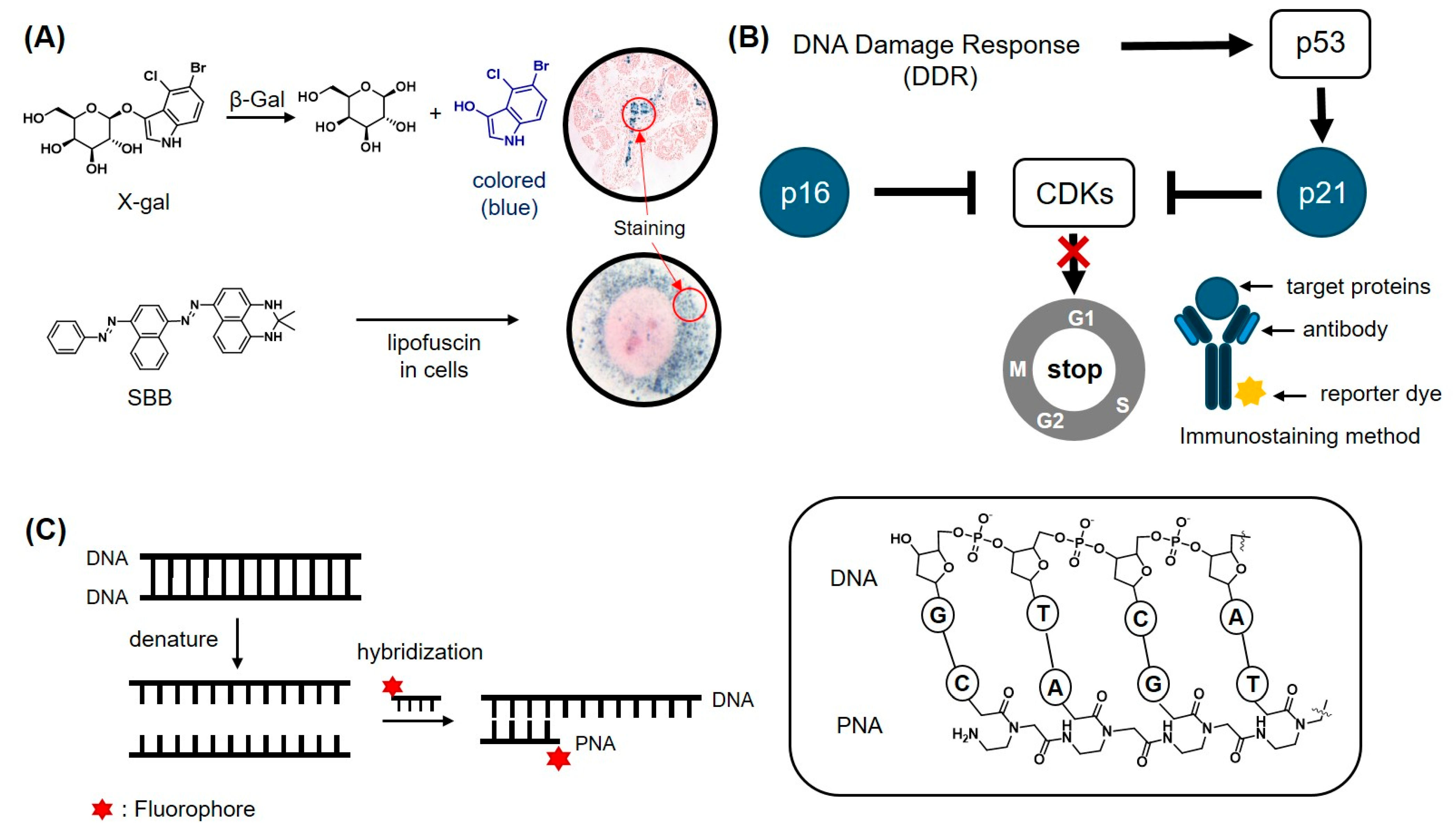
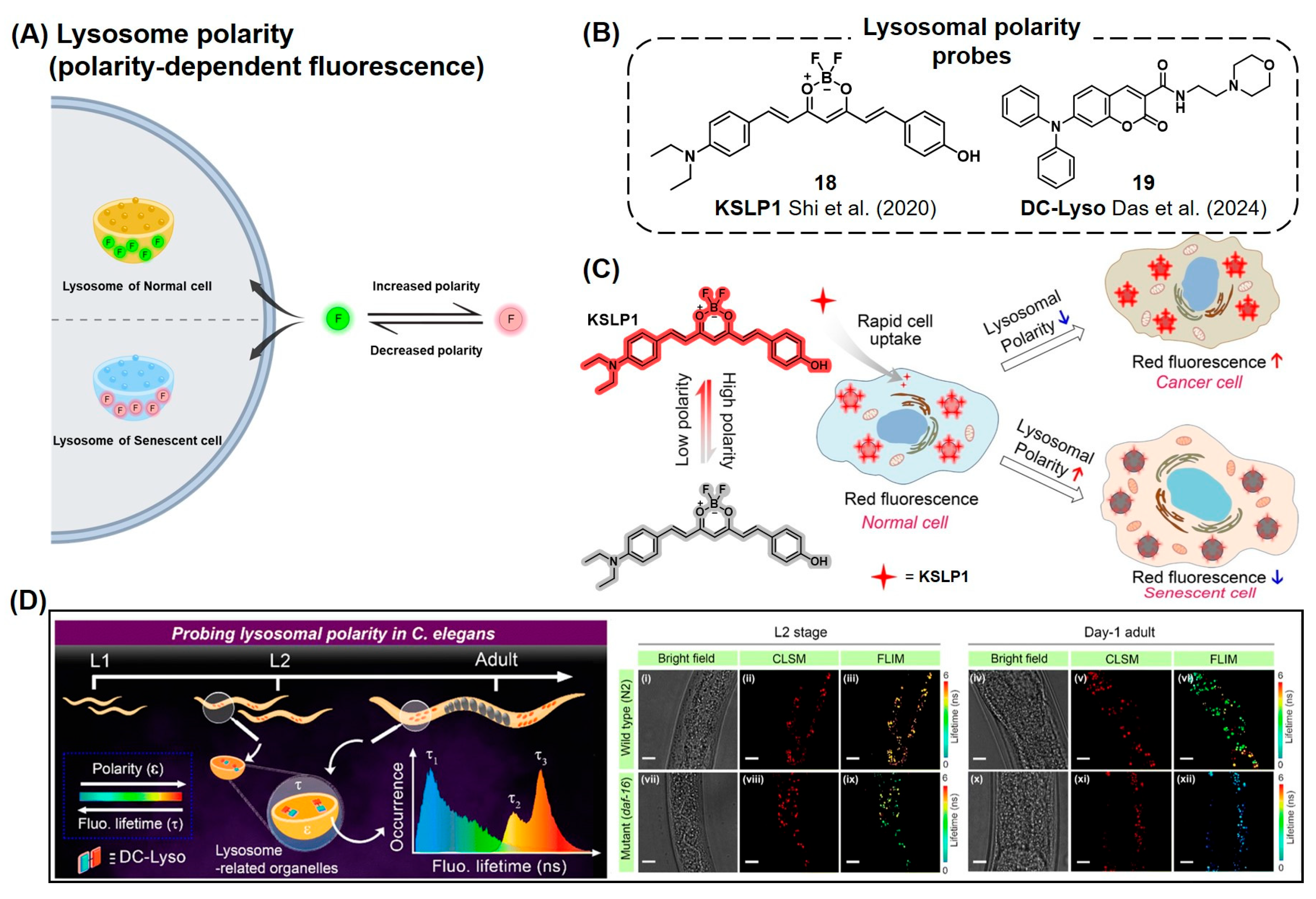


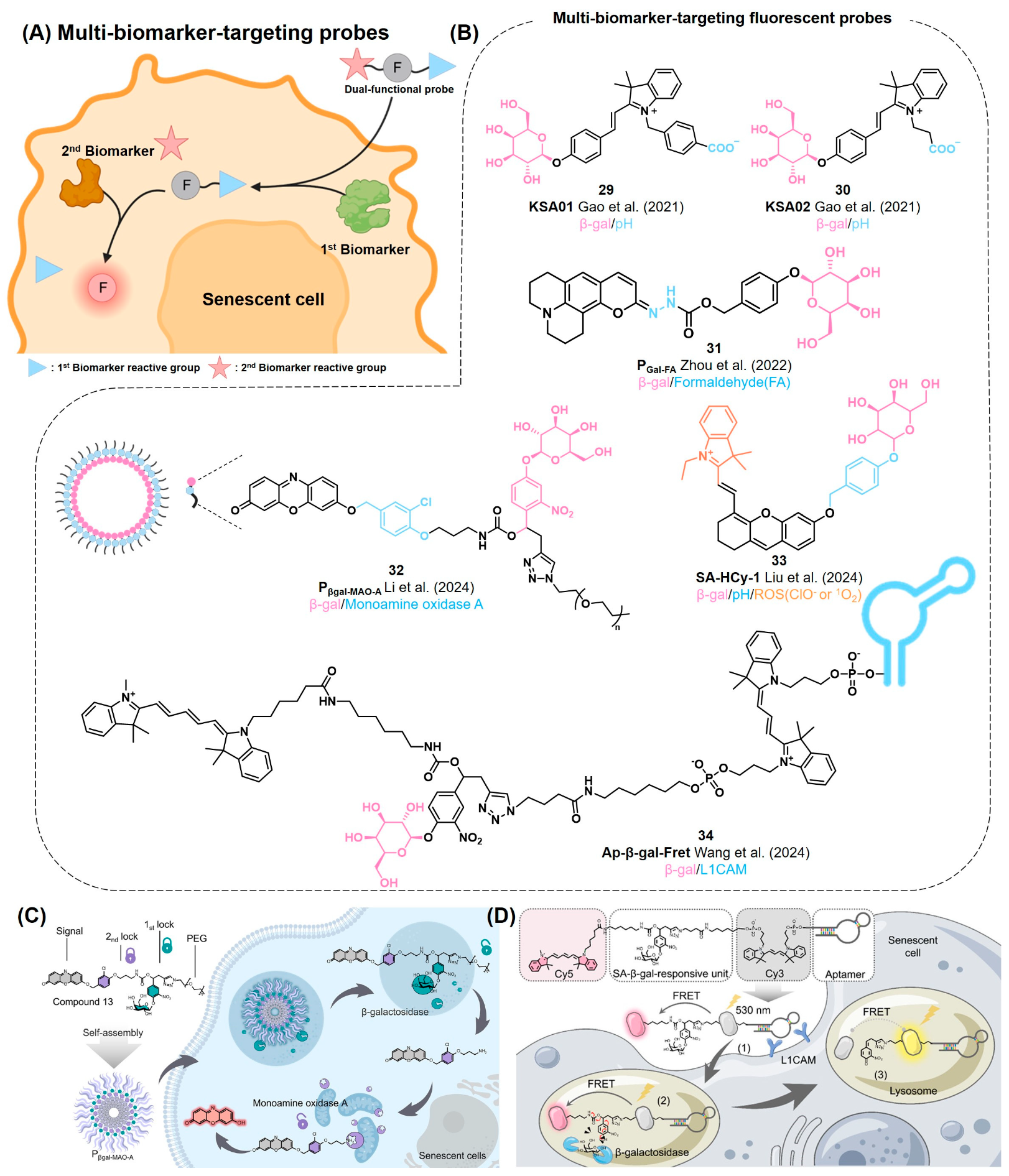
| Probe | Biological Target | Fluorescence Reporter | Reporter λex/λem (nm) | Detection Mechanism | Ref. | |
|---|---|---|---|---|---|---|
| 1 | SRP | SA-β-gal | Rhodol | 495/545 | Turn-on | [85] |
| 2 | KSL0401 | SA-β-gal | Coumarin–dicyanoisophorone | 435/706 | Turn-on (NIR) | [86] |
| 3 | DCMCA-βgal- | SA-β-gal | DCM-NH2 | 526/676 | Turn-on (NIR) | [87] |
| 4 | HBT-gal | SA-β-gal | HBT | 415/492 | Turn-on | [91] |
| 5 | AHGa | SA-β-gal | Naphthalimide | 405/540 | Turn-on (two-photon) | [18] |
| 6 | YDGAL | SA-β-gal | Benzo[e]indole | 500/585 | Turn-on (two-photon) | [19] |
| 7 | TD-Gal6 | SA-β-gal | Tetraphenylethylene | 488/580–620 | Turn-on (AIE) | [96] |
| 8 | SG1 | SA-β-gal | Benzothiazole–naphthalene (hybrid) | 378/540 | Ratiometric (two-photon) | [99] |
| 9 | TZ-Br | SA-β-gal | Dicyanoisophorone | 415/670 | Ratiometric (NIR) | [100] |
| 10 | P1 | SA-β-gal | Benzothiazolyl acetonitrile | 470/533 | Ratiometric | [20] |
| 11 | SPiDER-βGal-1 | SA-β-gal | Rhodol | 525/560 | Turn-on and covalent labeling | [101] |
| 12 | NIR-BG2 | SA-β-gal | Hemicyanine | 675/708 | Turn-on and covalent labeling (NIR) | [102] |
| 13 | Gal-Cy-Gd-1 | SA-β-gal | Hemicyanine | 687/717 | Turn-on and covalent labeling (NIR) | [103] |
| 14 | QM-NHαfuc | SA-α-fuc | Quinoline–malononitrile | 543/586 | Turn-on (AIE) | [21] |
| 15 | MitoCy-NH2 | MAO-B | Heptamethine cyanine | 730/770–810 (650/700–740) | Ratiometric (NIR) | [106] |
| 16 | Sia-RQ | Sialidases | Rhodamine-X | 580/610 | Turn-on | [111] |
| 17 | BD-AChE | Acetylcholinesterase | Aza–bodipy | 710/740 | Turn-on (NIR) | [112] |
| 18 | KSLP1 | Lysosomal polarity | Curcumin (boron-containing) | 560/700 | Solvatochromism | [113] |
| 19 | DC-Lyso | Lysosomal polarity | Aminocoumarine | 400/640 | Fluorescence lifetime | [114] |
| 20 | CyBC9 | Mitochondria potential | Cyanine | 649/670 | Accumulation | [115] |
| 21 | TANG | Mitochondria potential | Merocyanine | 520/573 | Intramolecular cyclization | [116] |
| 22 | LW-1 | Lipid droplet (LDs) | Nile Red | LDs: 540/620 | Solvatochromism | [119] |
| Protein aggregates (PAs) | PAs: 600/687 | |||||
| 23 | SBB-N3 | Lipofuscin | BODIPY | 505/516 | Accumulation | [122] |
| 24 | Qcy-BA | H2O2 | Quinone cyanine | 565/680 | Turn-on (NIR) | [123] |
| 25 | b-PyTPA | H2O2 | PyTPA | 488/669 | Turn-on (AIE) | [124] |
| 26 | RT-ER | ClO− | Rhodamine and naphthalene | 555/576 | Ratiometric | [22] |
| 27 | FLASN | ONOO− | Flavonol | 425/525 | Turn-on | [23] |
| 28 | D3 | O2− H2O2 NO | Cyanine | 665/700 | Turn-on | [125] |
| 29 | KSA01 | Two-dimensional: β-gal, pH | Merocyanine | 460/569 | β-gal: Turn-on pH: Ratiometric | [126] |
| 30 | KSA02 | 460/562 | ||||
| 31 | PGal-FA | Two-dimensional: β-gal, Formaldehyde | Coumarin–hydrazonate | 451/526 | Turn-on | [127] |
| 32 | Pβgal-MAO-A | Two-dimensional: β-gal, MAO-A | Resorufin | 570/620 | Turn-on | [128] |
| 33 | SA-HCy-1 | Three-dimensional: β-gal, pH, ROS (ClO−, 1O2) | Cyanine | 360/468 | β-gal, pH: Turn-on ROS: Ratiometric | [129] |
| 34 | Ap-β-gal-Fret | Two-dimensional: β-gal, L1CAM | Cyanine | 530/568 | Ratiometric | [130] |
Disclaimer/Publisher’s Note: The statements, opinions and data contained in all publications are solely those of the individual author(s) and contributor(s) and not of MDPI and/or the editor(s). MDPI and/or the editor(s) disclaim responsibility for any injury to people or property resulting from any ideas, methods, instructions or products referred to in the content. |
© 2024 by the authors. Licensee MDPI, Basel, Switzerland. This article is an open access article distributed under the terms and conditions of the Creative Commons Attribution (CC BY) license (https://creativecommons.org/licenses/by/4.0/).
Share and Cite
Park, J.; Lee, Y.; Park, J. Recent Developments in Small-Molecule Fluorescent Probes for Cellular Senescence. Chemosensors 2024, 12, 141. https://doi.org/10.3390/chemosensors12070141
Park J, Lee Y, Park J. Recent Developments in Small-Molecule Fluorescent Probes for Cellular Senescence. Chemosensors. 2024; 12(7):141. https://doi.org/10.3390/chemosensors12070141
Chicago/Turabian StylePark, Junyoung, Youngjun Lee, and Jongmin Park. 2024. "Recent Developments in Small-Molecule Fluorescent Probes for Cellular Senescence" Chemosensors 12, no. 7: 141. https://doi.org/10.3390/chemosensors12070141
APA StylePark, J., Lee, Y., & Park, J. (2024). Recent Developments in Small-Molecule Fluorescent Probes for Cellular Senescence. Chemosensors, 12(7), 141. https://doi.org/10.3390/chemosensors12070141





